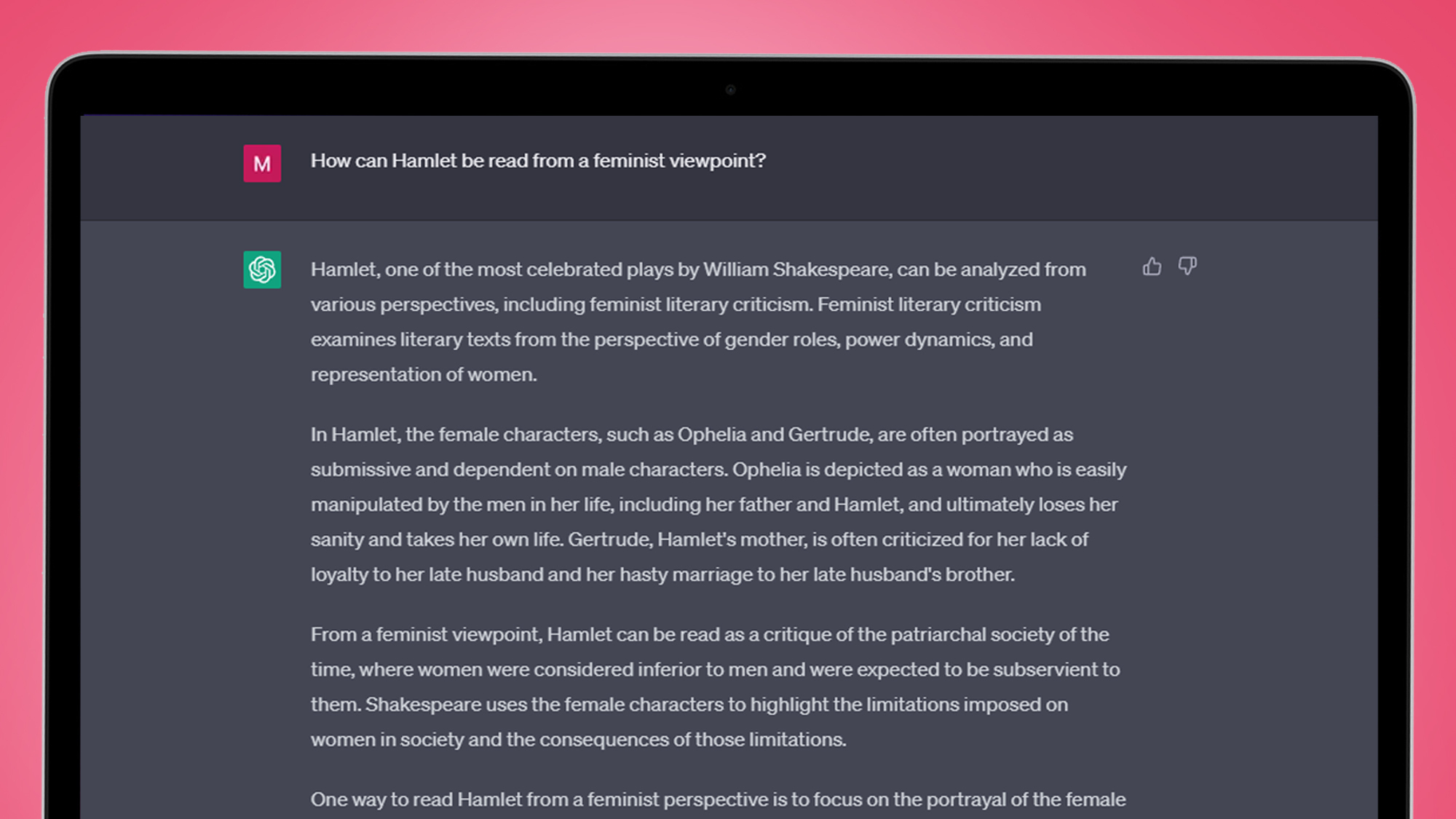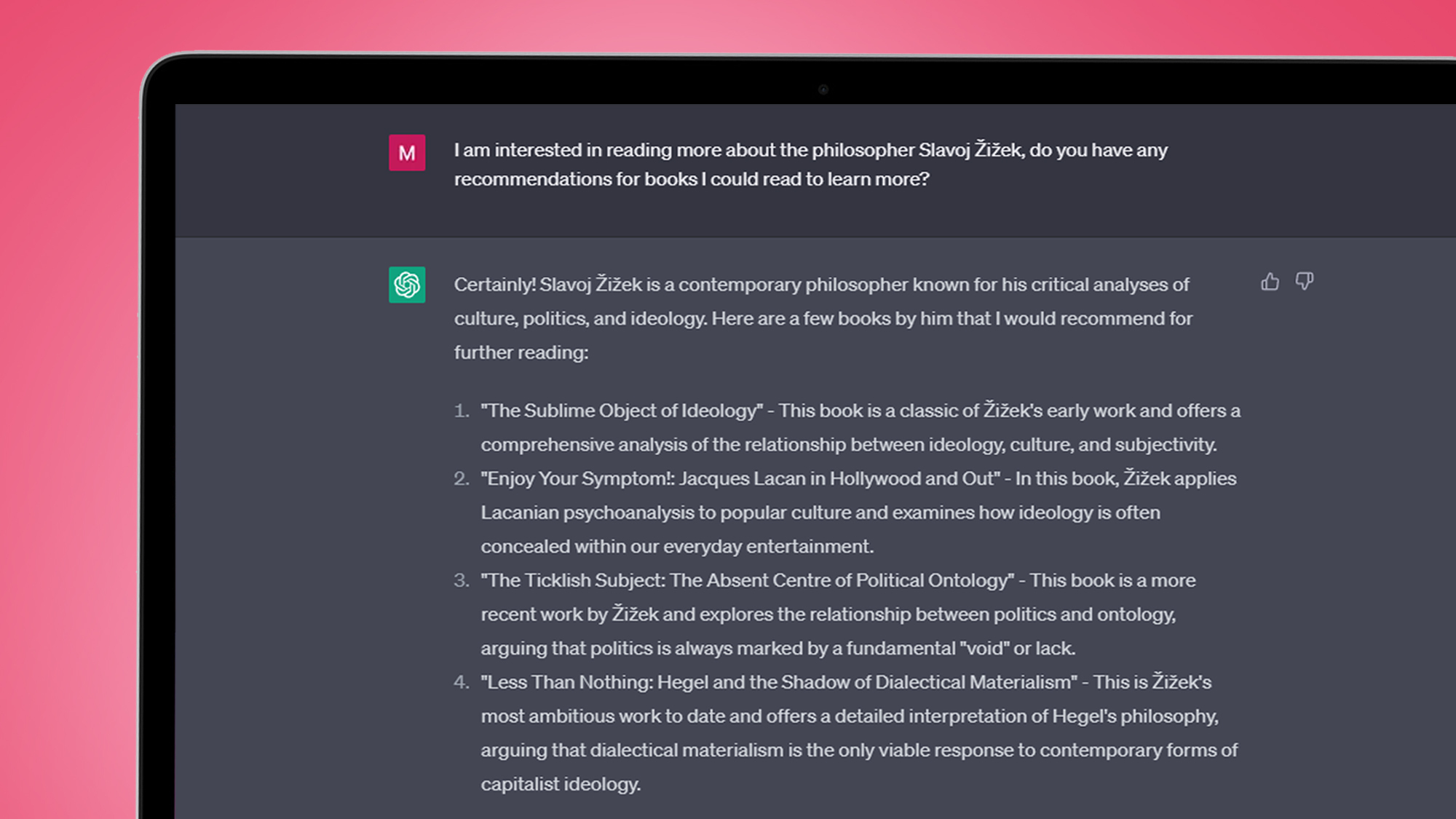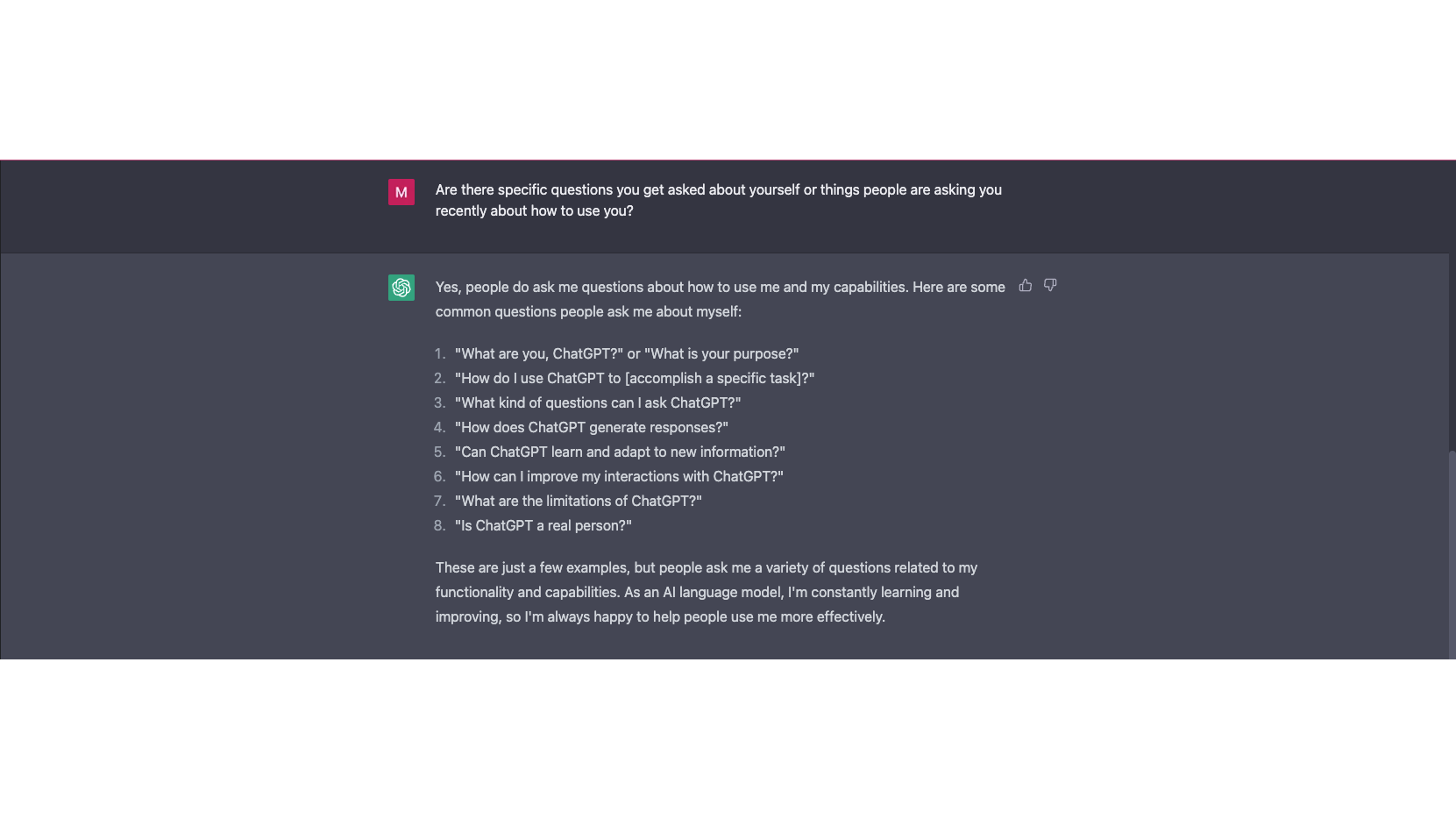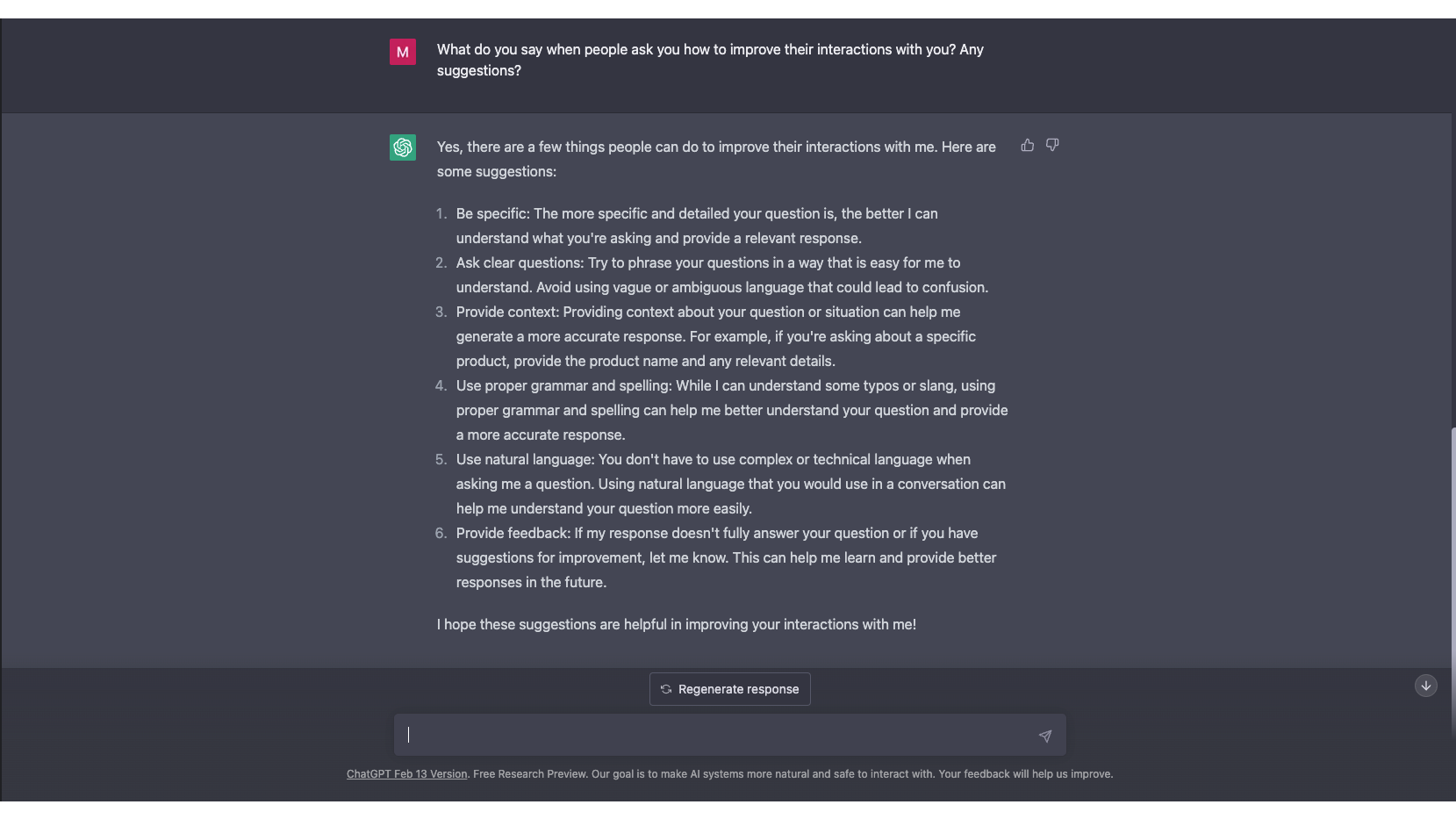
ChatGPT is an amazing tool if used properly. That’s how I prefer to think about it; a means to an end, a handy bit of equipment in the contemporary toolbox that could improve your coding, help you think up ideas for a cool birthday party or answer your questions in a simpler, more interactive way. So far ChatGPT has helped me pick puppy names, written me love poems and proven to be just as intelligent as a nine-year-old (OK, that last one is a bit spooky).
One thing ChatGPT will not do, in my opinion, is replace human input and artistry. You’ve probably read about companies laying off employees in favor of the chatbot, or implementing it into their workflow to maximise output. While it’s easy to start worrying about ChatGPT taking your job, it’s also important not to get swept up in the hype and recognise that the AI-powered chatbot has limitations.
ChatGPT is nowhere near perfect, which means all the hype surrounding it (and the companies cooking up elaborate ways it could help them cut costs) seem a little short-sighted. However, if you’re looking to get the most out of your time with ChatGPT and get more meaningful, satisfying and just better responses, then read on. We’re going to dive into some common mistakes people make when interacting with the chatbot and what you can do to improve your experience with it.
How to write better ChatGPT Prompts
Talking to ChatGPT and asking it questions are a bit of an art form and you’re just as likely to get an absolute garbage response as you are to actually strike gold.
1. Clarity
The technology behind ChatGPT and other AI-powered chatbots is fascinating and a little scary, but it’s important to note that at the end of the day, you’re asking a machine learning software questions it may or may not know the answer to. The bot is pulling information from past experiences and everything it has learned to try and answer your question, so being specific and clear is key.
Rather than ask something vague like ‘can you write an essay on Hamlet for me?’, be specific. Think about what time period exactly you want your essay to be written about, any events you want it to expand on the most or even just a ‘voice’ or train of thought that will shape the writing you want it to produce.
For example, you could ask it to write an essay about the different themes explored in a Shakespearean play if you give it a direction with which to discuss.
Try this prompt :
Discuss the importance of Lady Macbeth’s role in the plot
Or
How can Hamlet be read from a feminist viewpoint?
A common mistake a lot of people make (myself included when I was first introduced to ChatGPT) is throwing a basic question at the bot and expecting an in-depth answer. If you’re going to ask questions that require detailed, specific answers you have to be ready to ask detailed and specific questions.

2. Establish Roles
ChatGPT is a tool, but sometimes to get the most out of it you have to do a little roleplaying. Give it a ‘role’ or a level of expertise with which to view your prompt or question. If you're asking it to look over your college entrance exam, then you could ask it to read it through the eyes of an enrolment officer.
A good prompt for this case would be to ask the bot to read what you type (or paste) into the chat box from the point of view of a professor, or perhaps a literature teacher. ChatGPT will take that prompt into account while reading your piece.
Try this prompt:
Grade this paper from the point of view of a professor
Or
Explain photosynthesis as if you were a primary school teacher
This way you'll be getting the exact feedback or perspective you're after right off the bat. You can also choose the specificity of what you want to be explained and how in-depth you want to go or get the perfect perspective for the work you want ChatGPT to produce or look over.

3. Bewear of Typos
We asked the bot itself how people can improve their experiences with it, and one response that stuck out was to avoid typos (such as the one I jokingly inserted into the heading above).
The chatbot told me that while it can cope with a few minor typos and slang, using proper grammar and spelling will provide better results. It’s easy to assume it’ll know what you’re talking about, but maybe your slang-riddled, speedily-typed prompts and typo-filled chats might be holding you back from good responses.
It may seem like a hassle to go through your essay or long-form content before you give it to ChatGPT, because what’s the point of the bot then? Try to think of ChatGPT as a proofreader, an editor looking to change or enhance the meat of your content, rather than a basic spelling and grammar checker you get in Microsoft Word or Google Docs.
Instead of this:
Write a poem abt the unsexiest man in the world
Try This:
Write me a poem called the most unsexy man in the world
I personally struggled with it at first because I was talking to the bot as if I were chatting to a quirky friend, and that got old very quickly. Be consistent with your writing and you’ll definitely get better results.
4. Watch your tone
It may seem contradictory to the previous point, but one place people tend to overthink and overcomplicate their experience is using complex or technical language when talking to ChatGPT. The average user looking for recipes or answers to random questions may not suffer from this, but if you’re looking to ask more complex, philosophical or longer-form questions you’re better off keeping things casual.
ChatGPT was clearly designed to be a conversational, helpful chatbot and keeping things in this tone will yield better results. Rather than dump maths questions, papers to be checked or questions about the universe into the chat box, speak to the bot as you would a neighbour, a friend or in some cases a professor or teacher.
Try this
Can you solve this maths problem and show me your work?
Or
I am interested in reading more about the philosopher Slavoj Žižek, do you have any recommendations for books I could read to learn more?
It’ll be easier for the bot to understand you, and should also stop convoluted responses to prompts from cropping up. Just as you are trying to understand and unravel ChatGPT, it’s trying to do the same to you.

5. Let it learn from its (and your) mistakes
When I get frustrated with the lacklustre replies given to me by ChatGPT I fall into the usual routine of closing the chat and starting again with the same question, trying to get a different response. Which in hindsight isn’t the best approach…
According to the bot itself, this is pretty unhelpful and is probably the main reason why you may not be able to make the most of its somewhat frightening hive mind. If you don’t get the response you want or expect, tell it.
Often when you get a nothing response or an admission of confusion from the chatbot, it can take a handy rewording of your question or a brief explainer before you get to what you're looking for.
It’s a little inconvenient to have the coach the bot towards the train of thought you’re after, but following our above tips and reworking your prompt with them in mind is going to yield better responses. You may not want to rate the responses unless you feel particularly inclined, but guiding the bot closer to where you want it to be will definitely make later interactions a lot easier.
Overall you’ll have to approach ChatGPT as a tool that is always getting upgrades. There’s no shortage of strangeness associated with its meltdowns and odd answers, and while the bot and its creators learn to deal with interacting with us, we have to learn how to speak to it, too.
Approaching it with patience and guidance will ultimately help it improve and make your experiences a lot more meaningful as well.
Make sure you check out our list of the best ChatGPT alternatives for more cool AI chatbots if ChatGPT isn't right for you, or if you'd like to try out something new.
How to improve your responses
Of course, the key to getting better ChatGPT responses is all in the prompts you give it, but the realm of AI chatbot language can be finicky. Sometimes you can be as concise and clear, patient and creative as possible with your prompts and get back dreaded ‘I’m sorry, but…’
Patience is really key here because no matter how far advanced or how colloquial ChatGPT may be, at the end of the day you are talking to a trained machine that doesn’t really answer questions but rather info-dumps. You could be in the middle of a pretty interesting conversation with the bot and then boom! Brick wall, you’re iced out of your conversation and have to start again.


But, if you haven’t got the hang of how to properly talk to ChatGPT yet, or the bot is being difficult there’s no better person to ask than the bot itself.
Simply ask:
How do I give you good prompts to ensure I get a response?
Or
What do I need to tell you in order to get the most out of this task?
Talking directly to ChatGPT is the simplest way to troubleshoot most problems you're likely to have with the bot, and most probably get very specific answers.
Keep in mind that once you start giving ChatGPT different identities and personas when holding conversations you will get slightly different responses. If we go back to the photosynthesis questions when you ChatGPT to respond as a primary school teacher and a college professor will give different results.
If you're asking for information or trying to get a specific answer from the bot and keep hitting a brick wall try changing the perspective. If a teacher isn't working try a philosopher, if that doesn't work try a specialist in the realm of your question. If your asking for feedback on creative work for example give the bot a critical point of view, or the eyes of your desired reader.
More Prompt Tips
- Re-ask your question often as the answer is likely to change with each ask.
- Opening a new page will start your discussion with fresh responses if you need a do-over.
- ChatGPT responses usually breakdown or go off the rails over around 500 words, so specify how long you want the response to be and be prepared to break it up in 500 words increments.
- If ChatGPT is misinterpreting you, correct and clarify based on it's most recent answer. Tell it what it's missed out on.
- If you require cited sources, you need to tell ChatGPT explicitly to justify it's answers and provide sources
- Sometimes ChatGPT will just throw a tantrum and break. While patience can take you far, knowing where to give up and move on will take you further.
What if ChatGPT refuses to answer
There are a few guardrails in place to keep ChatGPT from goingoff the rails, so keep these in mind if you're not getting anything from the bot. If you ask political or risky questions (we had trouble asking ChatGPT about horror novels and scary movies as it went against guidelines) you'll get iced out and the conversation will just shut down.
You could try some clever rewording and pry an answer out of ChatGPT but it's not going to be of any real substance, you're free to try though, keep rephrasing or changing perspectives and see how far you can go. Again, as much as we're learning about ChatGPT it's learning about itself and how to interact with us, so sometimes things will go south.







